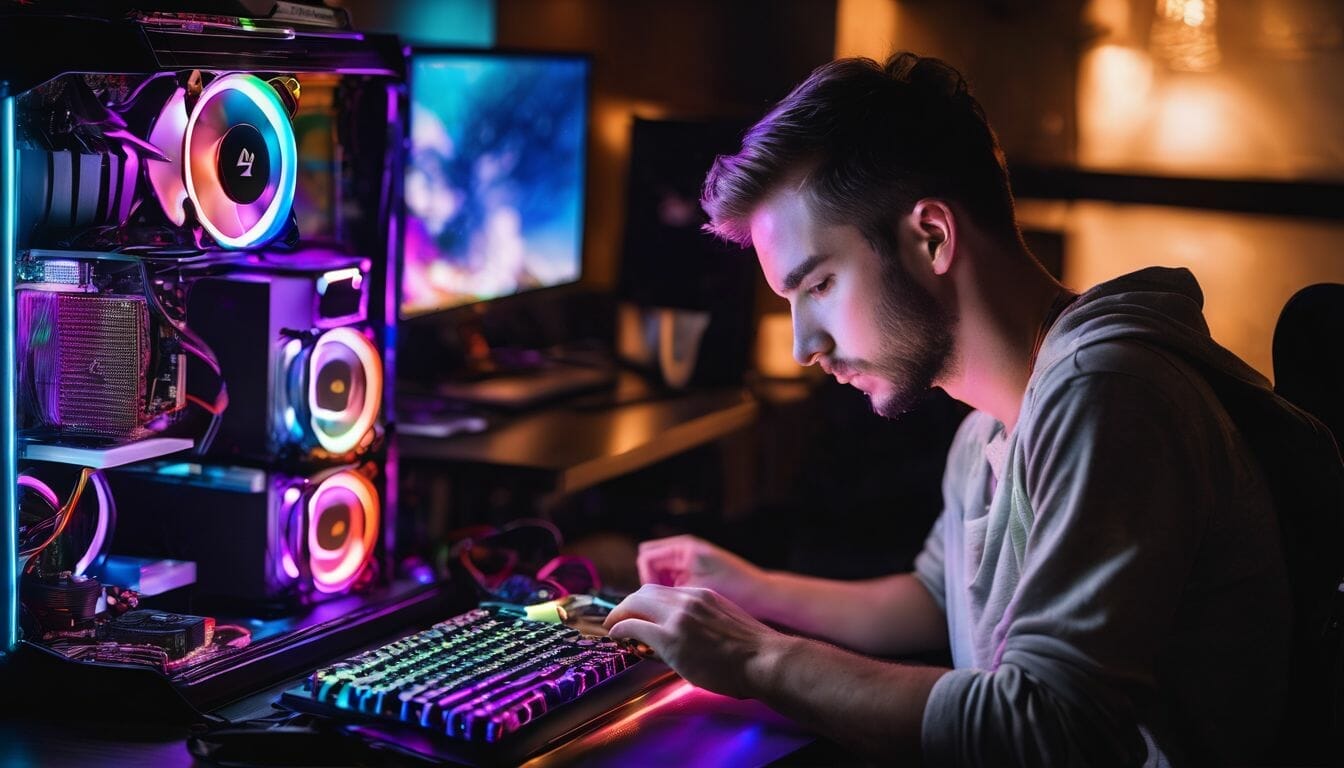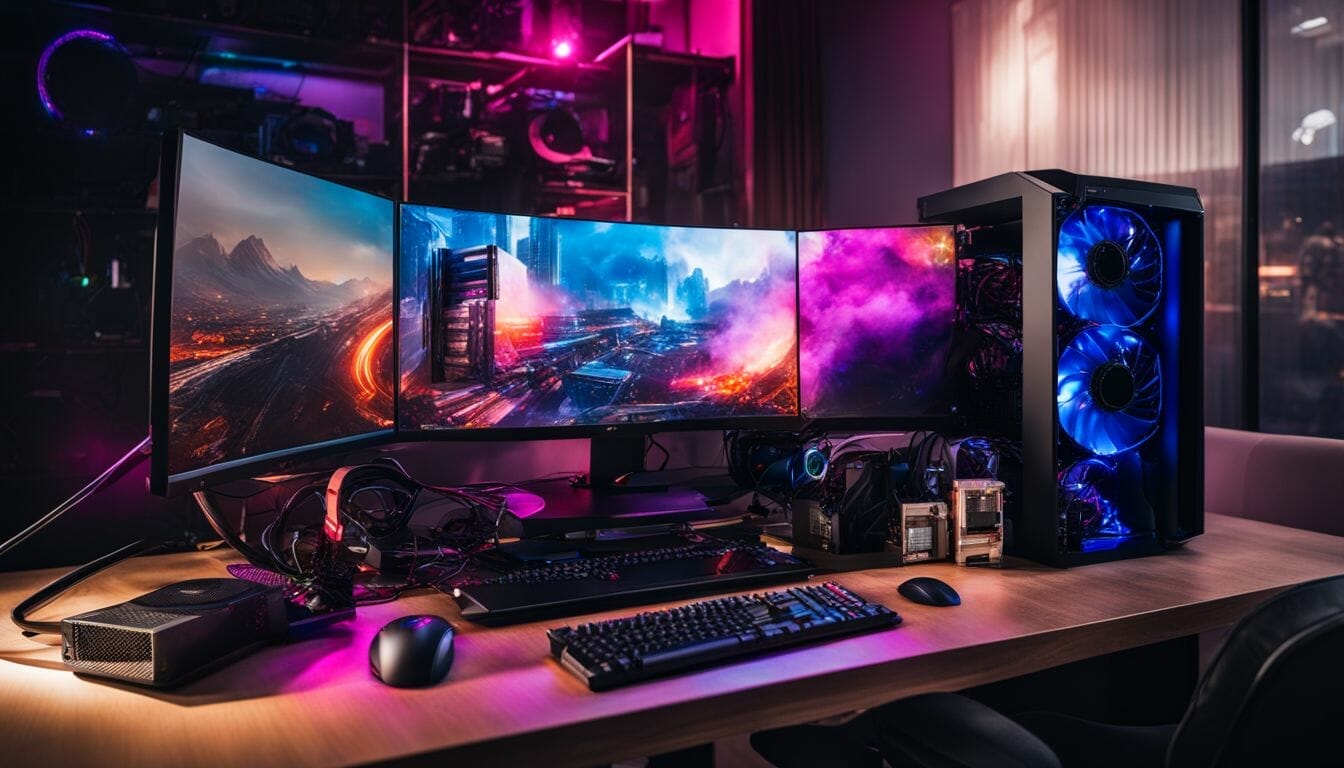Cooling Your Gaming PC: How Many Fans Are Enough?

Have you ever pondered the number of fans required to maintain a cool gaming PC during intense operation? It’s an intriguing inquiry, and our investigation has been thorough to understand it better. Our findings reveal that there isn’t a one-size-fits-all answer. The amount of cooling needed depends on several variables, including the specific parts of your system, how your PC case is set up, and the level of cooling performance you desire.
In this blog post, we’ll guide you through understanding fan configurations and their significance in maintaining an optimal temperature for your gaming PC. Ready to unlock the secret for a cooler gaming experience? Let’s go!
Key Takeaways
- Fans in a gaming PC are crucial for maintaining optimal temperatures and preventing overheating.
- The number of fans needed depends on factors like case size, hardware components, and desired cooling performance.
- General guidelines suggest having at least three fans – two for intake and one for exhaust – but the actual number may vary based on workload and components.
- Proper fan placement, such as placing intake fans at the front and exhaust fans at the back, is key to creating good airflow.
Understanding the Importance of Fan Configuration in a Gaming PC

Fans in a gaming PC play a crucial role in maintaining optimal temperatures and preventing overheating, which can lead to performance issues and potential hardware damage.
How fans affect temperatures in a PC
Fans cool down our gaming PCs. They push hot air out and pull in cool air. This process is called airflow. When PC parts work hard, they make heat. Too much heat can harm them or slow them down.
The fans keep the PC’s temperature low for the best gaming experience. It helps our game run smooth and fast while protecting our hardware from damage due to high heat levels.
Importance of proper airflow and cooling
Airflow is key to keeping our gaming PC in top shape. Cool air works like water on a hot car engine, it cools down the parts that heat up when we game. If there’s not enough flow of cool air, our PC can get too warm.
This causes slow play and harms the computer parts over time.
Fans keep this from happening as they move cold air into the case while pushing out hot air. It’s crucial they’re set up right for best results! Two fans at the front suck in fresh, cool air.
One fan at back removes hot air that builds up inside during intense gaming sessions. This setup helps control dust and keeps our machine running smooth for longer. So good airflow and cooling are important to enjoy fast-paced games without any hiccups!
Determining the Number of Fans Needed for a Gaming PC

To determine the number of fans needed for a gaming PC, consider factors such as case size, hardware components, and desired cooling performance.
General guidelines for fan placement
Let’s talk about the best ways to place fans in your gaming PC for great cooling. Here are some easy rules to follow:
- As a start, put at least three fans in your PC case. Two should act as intake fans and one as an exhaust fan.
- Always think about the size of your case and its airflow. This will decide how many fans you need.
- Take note of how much heat your components make. If they get too hot, you might need more fans.
- Placement matters a lot! Intake fans should go at the front or bottom of the case to pull in cool air.
- Put your exhaust fan at the back or top of the case to push hot air out.
- Try not to let cords block air circulation inside the case.
- Remember that more fans may be needed for heavy gaming workloads.
- And lastly, balance is key! Even cooling can stop any one part from getting too hot.
Factors to consider, such as case size and components
When setting up a gaming PC, it’s important to consider certain factors that will affect the number of fans needed. These factors include:
- Case size: The size of your PC case will determine how many fans it can accommodate. Larger cases like mini-tower, mid-tower, and super cases can usually handle more fans than smaller form factor cases.
- Component heat: Different components in your PC, such as the CPU and GPU, generate varying levels of heat. If you have high-performance components or plan on overclocking, you may need additional fans to cool them effectively.
- Airflow requirements: Proper airflow is crucial for maintaining optimal temperatures inside your PC. Consider the airflow needs of your components and ensure that all areas of the case are getting adequate cooling.
- Fan placement: The placement of your fans can greatly impact their effectiveness. It’s important to strategically position them to create good airflow throughout the case and help dissipate heat efficiently.
Optimal Fan Placement for Maximum Cooling
To achieve maximum cooling in a gaming PC, it is important to consider the optimal placement of intake and exhaust fans.
Intake vs. exhaust fans
Intake fans and exhaust fans play a crucial role in keeping your gaming PC cool. Intake fans draw in fresh, cool air from outside the case, while exhaust fans expel hot air from inside the system.
Having more intake fans than exhaust fans is generally recommended to ensure proper airflow and cooling efficiency. By positioning intake fans at the front or side of your case and exhaust fans at the rear or top, you can create a steady flow of air through your PC, preventing heat buildup and maintaining optimal temperatures for your components.
With this balanced fan configuration, you can enjoy longer gaming sessions without worrying about overheating issues that could potentially shorten the lifespan of your precious hardware.
Best practices for fan placement in different cases
Proper fan placement is essential for keeping your gaming PC cool and maximizing its performance. Here are some best practices to follow when positioning fans in different cases:
- Have at least three case fans: It is recommended to have two intake fans and one exhaust fan for optimal cooling.
- Place intake fans at the front: Position the intake fans at the front of your case to bring in fresh cool air from outside.
- Position exhaust fan at the back: The exhaust fan should be placed at the back of the case to expel hot air generated by your components.
- Create a wind tunnel effect: By having one intake fan and one exhaust fan, you can create an ideal airflow configuration that allows for efficient heat dissipation.
- Consider additional fans if needed: Depending on your components and case size, you may need extra fans to ensure sufficient cooling.
Other Factors to Consider for Cooling a Gaming PC
When it comes to cooling a gaming PC, there are several other factors that need to be considered. These include the cooling solutions for the CPU and GPU, as well as additional options like liquid cooling.
Proper heat dissipation is crucial in ensuring optimal performance and longevity of your hardware components.
CPU and GPU cooling solutions
When it comes to cooling your gaming PC, there are a few options for CPU and GPU cooling solutions. For the GPU, most gaming graphics cards come with pre-installed fans in a shroud that help keep temperatures down during intense gaming sessions.
These fans work by drawing cool air into the card and expelling hot air out of the back or top of your case. As for the CPU, you have the choice between air cooling and liquid cooling.
Air cooling involves using a CPU cooler with heat sinks and additional fans to dissipate heat generated by the processor. On the other hand, liquid cooling uses a system of tubes filled with coolant to transfer heat away from the CPU more efficiently than just relying on fans alone.
Additional cooling options, such as liquid cooling
Liquid cooling is an alternative option for cooling gaming PCs. It’s more efficient in distributing heat over a larger surface area compared to air cooling. With liquid cooling, you don’t need as many fans inside your PC case.
This means quieter operation because the fans can rotate at slower speeds. So if you want a cooler and quieter gaming experience, liquid cooling could be a great choice for you.
Conclusion: Finding the Right Balance for Cooling a Gaming PC
In conclusion, the number of fans needed for a gaming PC depends on factors like heat dissipation and airflow. Generally, it’s recommended to have at least three fans – two for intake at the front and one for exhaust at the back.
However, the actual number may vary based on workload and hardware components. It’s important to find a balance that provides optimal cooling without creating excessive noise. Consulting experts or experienced builders can help determine the right fan setup for your specific gaming PC.
FAQs
1. How many fans does a gaming PC need?
A gaming PC typically needs at least two to three fans for proper cooling and airflow.
2. Can I add more fans to my gaming PC?
Yes, you can add more fans to your gaming PC if you want better cooling performance or if your components require additional airflow.
3. What are the benefits of having more fans in a gaming PC?
Having more fans in a gaming PC helps disperse heat, keeping the internal components cooler and reducing the risk of overheating, which can improve performance and extend the lifespan of your system.
4. Do I need any special tools or skills to install extra fans in my gaming PC?
Installing extra fans in a gaming PC usually doesn’t require any special tools, but it’s important to follow manufacturer instructions carefully and ensure proper placement and connection of the new fans.
5. Are there any drawbacks to having too many fans in a gaming PC?
Having too many unnecessary or improperly placed fans could lead to excessive noise levels without providing significant improvement in cooling efficiency. It’s essential to find a balance based on your specific hardware requirements and case design.

